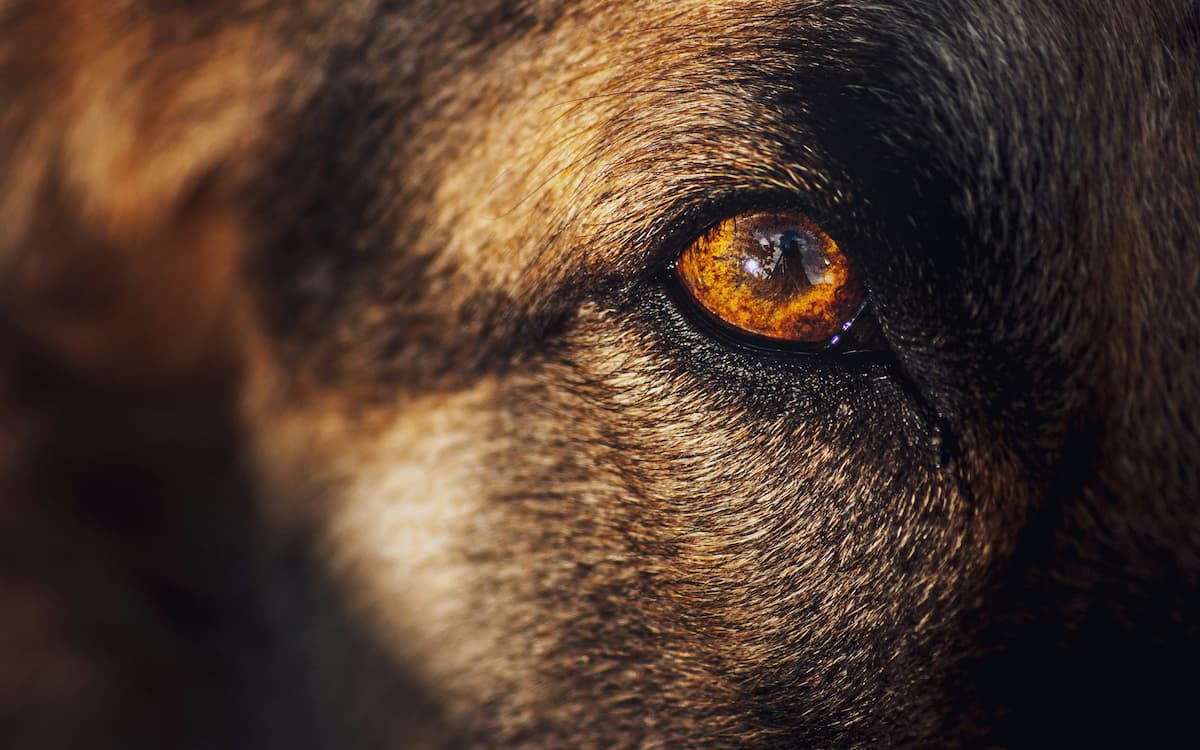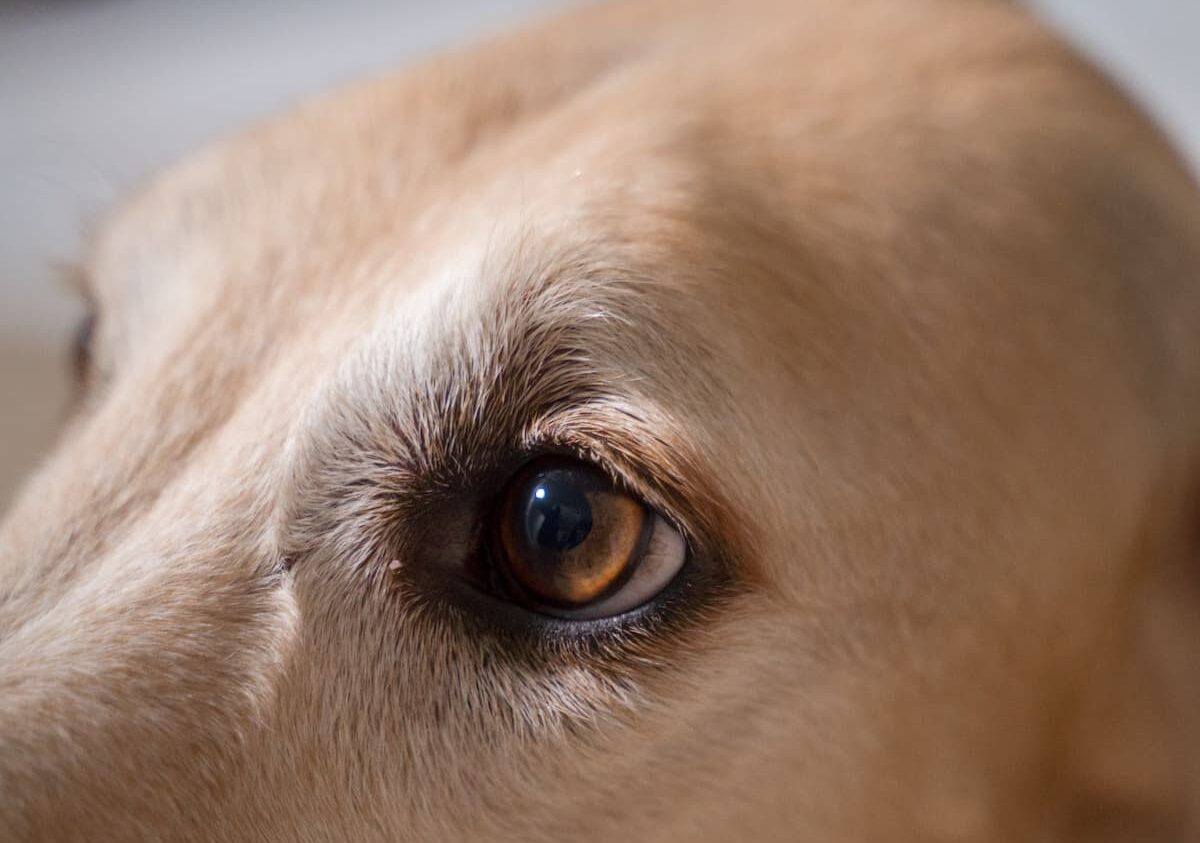Picture this: it’s a calm summer evening, the day begins to wind down, and you find yourself lovingly staring into your furry companion’s eyes when something utterly unexpected catches your attention.
The familiar sparkle in your dog’s eyes has been replaced by an eerie crimson glow that makes your heart skip a beat.
Questions start racing through your mind faster than Fido chasing squirrels at the park: “Why are my dog’s eyes red? Is it something serious? Could it be Halloween already?”
This article will answer all of your questions.
Exploring Causes of Dogs’ Red Eyes for Better Understanding
When you look into your furry friend’s eyes, the last thing you want to see is a reddish hue staring back at you.
Red eyes in dogs can be concerning, but don’t panic just yet!
There are several common causes for this condition, and most of them are easily treatable:
Allergies and Irritations
Just like humans, dogs can experience allergies and irritations that lead to red eyes.
Dust, pollen, or certain cleaning products can cause an allergic reaction, leaving your dog with itchy and red eyes.
You might notice your furry pal scratching or rubbing their face excessively.
Additionally, some breeds are more prone to dry eye syndrome, also known as keratoconjunctivitis sicca, which can cause redness and discomfort.
Thankfully, there are over-the-counter eye drops to help alleviate the symptoms and keep those peepers clear and bright.
Eye Infections
Another common cause of red eyes in dogs is an eye infection.
Conjunctivitis, commonly referred to as “pink eye,” can cause redness, discharge, and even swelling.
Bacterial or viral infections can be transmitted through direct contact with an infected dog or contaminated objects.
In some cases, red eyes in dogs can also be a sign of a more serious underlying condition such as glaucoma or uveitis.
Glaucoma occurs when there is increased pressure within the eye, which can lead to redness, pain, and cloudiness.
Uveitis, on the other hand, is inflammation of the uveal tract of the eye and can cause redness, reduced vision, and discomfort.
It’s important to keep an eye out for these symptoms, especially if your dog spends time in crowded places, such as dog parks or daycare facilities.
If you suspect an infection, consult your veterinarian for proper diagnosis and treatment.
Dry Eye
Lastly, dry eye, also known as keratoconjunctivitis sicca (KCS), is a common condition that can contribute to red eyes in dogs.
This occurs when there is reduced tear production or poor tear quality, leading to dryness and inflammation of the eyes.
Dry eye can be caused by a variety of factors, including genetics, certain medications, or other underlying health conditions.
In addition to redness, you may also notice your dog squinting, rubbing their eyes, or experiencing excessive discharge.
If you suspect your dog may have dry eye, it is crucial to seek veterinary care to prevent further complications.
Tips for Preventing and Treating Red Eyes in Dogs
Whether it’s due to allergies, irritation, or an underlying health condition, red eyes can leave us worried about our furry friend’s well-being.
But fret not!
There are plenty of natural solutions to help soothe and calm your dog’s red eyes, ensuring their comfort and happiness.
First and foremost, it’s crucial to identify the root cause of your dog’s red eyes.
Allergies, such as pollen or dust, are a common culprit.
In this case, providing your pup with a clean and safe environment is crucial.
Regularly dust and vacuum your home, wash their bedding, and keep them away from potential allergens, like freshly cut grass or certain plants.
Additionally, consider using air purifiers to improve the air quality in your home.
By minimizing these triggers, you can alleviate your dog’s red eyes and reduce their discomfort.
Another effective natural solution is the use of cold compresses.
Just as we find relief in placing a cold cloth on our eyes, the same can work wonders for our four-legged companions.
Soak a clean cloth in cool water or herbal infusions, such as chamomile or eyebright, and gently press it against your dog’s closed eyes.
The cool temperature and herbal properties can help reduce inflammation, soothe itchiness, and provide immediate relief.
It’s important to remember to always use a gentle touch, ensuring your dog feels comfortable and relaxed throughout the process.
Prevention is key when it comes to red eyes in dogs.
Here are some tips to keep your furry friend’s eyes bright and healthy:
Regular Cleaning
Gently clean your dog’s eyes with a damp cloth or a pet-safe eye wipe to remove any dirt or debris that may have accumulated.
Avoid Irritants
Be mindful of potential irritants that can cause allergies or conjunctivitis in your dog, such as certain cleaning products, smoke, or strong fragrances.
Keep these irritants away from your pet.
Visit the Vet
If you notice persistent redness, discharge, or any other concerning symptoms in your dog’s eyes, it is important to schedule a visit with your veterinarian for a proper diagnosis and treatment plan.
When to Seek Veterinary Care for Your Dog’s Red Eyes
Red eyes in dogs can be a cause for concern, especially if they persist or if your furry friend is showing signs of discomfort.
While the occasional redness may be harmless, it’s essential to pay attention to any changes in your dog’s eyes and seek veterinary care when necessary.
Here are some situations when it’s crucial to schedule a visit to the vet:
1. Persistent redness: If your dog’s eyes remain red for an extended period, it might indicate an underlying issue.
This could range from simple allergies to more serious conditions like conjunctivitis or glaucoma.
A veterinarian will be able to diagnose the cause of the redness and recommend appropriate treatment.
2. Excessive tearing or discharge: If your dog’s eyes are red and have excessive tearing or discharge, it could be a sign of infection or injury.
The presence of green or yellow discharge may indicate bacterial conjunctivitis, while clear discharge could point to allergies.
A vet can determine the cause and provide the necessary medication or treatment to alleviate discomfort.
3. Changes in behavior or appearance: Keep an eye out for other signs alongside red eyes that may indicate your dog’s overall health is affected.
If your pooch is rubbing or scratching their eyes frequently, displaying sensitivity to light, or if you notice any changes in their vision, it’s time to consult a vet.
They will be able to assess the situation holistically and provide guidance on the best course of action.
Remember, your dog’s eyes are delicate organs, and any changes should not be ignored.
Regularly check their eyes for redness, discharge, or other abnormalities.
If you spot anything concerning, don’t hesitate to make an appointment with your veterinarian.
Prompt veterinary care can help ensure your furry friend’s eye health and overall well-being.
FAQ
Q: Why do dogs sometimes get red eyes?
A: Good question!
Dogs can develop red eyes due to various reasons, similar to how humans might get bloodshot eyes.
One common cause is something called conjunctivitis.
Q: Conjunctivitis?
What’s that?
A: Conjunctivitis, also known as pink eye, is an inflammation of the conjunctiva – the thin, clear tissue that covers the white part of the eye.
It can make your dog’s eyes appear red, swollen, and even produce discharge.
Just like when we have pink eye, it can be caused by allergies, infections, or irritants.
Q: Are there other reasons for their red eyes?
A: Absolutely!
Another potential culprit is a condition known as dry eye or keratoconjunctivitis sicca (KCS).
This happens when your furry friend isn’t producing enough tears to keep their eyes lubricated.
As a result, their eyes might become red, irritated, and even develop ulcers or infections.
Q: Can red eyes in dogs indicate something more serious?
A: While many cases of red eyes are temporary and easily treatable, there are some situations where it might indicate a more serious condition.
For instance, glaucoma - a buildup of pressure in the eye – can cause redness, pain, and even vision loss if left untreated.
So, it’s always wise to consult with your vet if you’re concerned.
Q: Can dog breeds or their age play a role in the occurrence of red eyes?
A: Absolutely!
Some dog breeds are more prone to certain eye conditions that can lead to redness.
Breeds with bulging eyes, like Pugs or Boston Terriers, are more susceptible to eye injuries and infections.
Similarly, older dogs are more prone to develop conditions like cataracts, which can contribute to red eyes.
Q: How can I help prevent or treat red eyes in my furry pal?
A: Prevention is key!
Regularly cleaning your dog’s eyes with a damp, warm cloth can help remove any dirt or irritants that may cause redness.
Additionally, keeping up with your pet’s veterinary exams ensures any potential eye issues are caught early.
If your pup does develop red eyes, be sure to consult your vet for proper diagnosis and treatment.
Q: Is it ever an emergency situation?
A: In some cases, yes.
If your dog’s red eyes are accompanied by severe pain, excessive discharge, sudden visual changes, or if they have injured their eye, it’s important to seek immediate veterinary care.
Your fur baby’s eyes are precious, and it’s better to be safe than sorry when it comes to their vision!
Summing Up
Whether it’s allergies, infections, or a pesky foreign object making its way into their peepers, they’re bound to sport the red-eye look.
If you notice any discomfort or unusual behavior, it’s crucial to consult a veterinarian who can diagnose and treat these conditions effectively.
Remember, our four-legged friends communicate through body language, so keeping an eye out for any changes in their eyes is always a good idea.
And don’t worry too much – with proper care and attention, those red eyes will be back to normal in no time!














